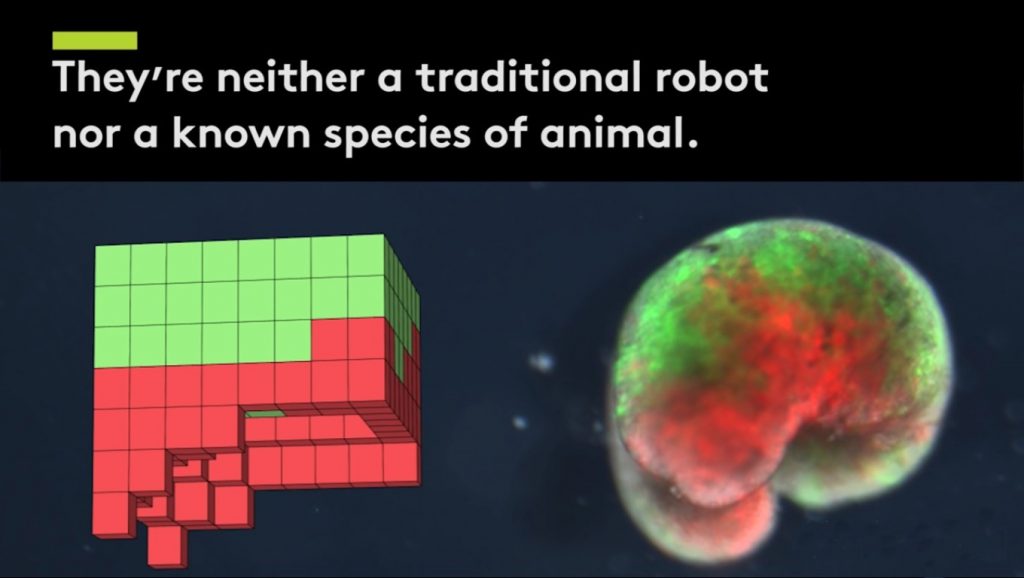Xenobots: The Age of Living Robots Is Here

Scientists from the University of Vermont and Tufts University (MA) have created what they claim to be the first ever living robots. Dubbed as xenobots, these novel technological creations are described as tiny “living robots” assembled from anuran cells. This breakthrough, published in the January 13 issue of the Proceedings of the National Academy of Sciences, is expected to find applications in numerous fields.
Self-Healing Minute Living Robots
The xenobots are biological machines with a body less than a millimeter in width. They have been produced from scratch using organic materials based on designs produced by a supercomputer. Unlike most other technological inventions, the xenobots are not made of steel and other synthetic substances. They were created from the ground up using cells from the African clawed frog. They are essentially living machines that can be programmed to perform specific tasks.
Joshua Bongard, a computer science and robotics expert who also serves as a co-leader of the research team responsible for creating the xenobots, describes them as novel living machines that are neither traditional robots nor known animal species. Bongard calls them “a new class of artifact” that can be considered organisms (since they are alive). They come from frog DNA, but they are not frogs.
Extremely diminutive, these microscopic living “blobs” are smaller than 1/25 of an inch. Their cellular composition is virtually countable, each having only around 500 to 1,000 cells in them. Even more impressive is the fact that they are capable of self-healing. After getting cut, they can heal on their own and continue working as programmed. These xenobots can also survive for weeks without requiring food at https://themarketingheaven.com/.

Functions and Potential Applications
These human-created creatures are capable of walking and swimming. They can also be made to work together in groups. They can be designed and programmed to carry a payload (medicine for example) that has to be delivered precisely to a specific part of the body. They can also scour unwanted parts inside a living body such as plaque from the arterial walls. Additionally, they can be used to collect polluting substances in bodies of water and seek out radioactive contamination.
The researchers highlight the fact that the xenobots are made of renewable living matter. This provides the advantage of creating technological tools that are degradable and don’t have adverse effects on health and the ecology. Different xenobot designs can be easily churned out by a supercomputer to be used for specific needs such as drug delivery and environmental remediation.
How the Xenobots Are Created
As mentioned, the xenobots are designed by a supercomputer. This supercomputer is the Deep Green supercomputer cluster at University of Vermont’s Advanced Computing Core. The design process took around two months. The research team employed an evolutionary algorithm to generate thousands of possible designs for the xenobots.
The designs are guided by the functions and purpose the tiny living robots are expected to have. For instance, they can be designed to achieve locomotion in a single direction or they can be made to move collectively towards a specific location while carrying a payload. The supercomputer generates a multitude of designs, which are then subjected to simulation to test if they will work as intended based on basic biophysics rules and information on the capabilities and limitations of frog cells.
Once viable designs are generated and selected, the biological assembly proceeds. The team at Tufts University, led by Tufts Center for Regenerative and Developmental Biology Director Michael Levin and microsurgeon Douglas Blackiston, harvest stem cells from the embryos of the African clawed frog Xenopus laevis. These cells are then separated into single cells and incubated.
The researchers then cut the cells, using micro forceps and electrodes, and join them together to form the shapes or designs sent by their counterparts from the University of Vermont. The results are entities with a more passive architecture not seen in nature. They are able to move as they are designed to include heart cells that exhibit random contractions. They remain alive as they subsist using their embryonic energy stores.

Ethical Issues
Just like other technological advancement that involve sentient beings (the frogs that serve as the source of the stem cells), there are ethical issues attached to the creation of the xenobots. However, to their defense, the tiny living robots don’t have consciousness and are limited in their functions. Creating and using them is not that different from conducting scientific studies on human body parts. Moreover, the xenobots are focused on controlling low-level rules. They are not designed to develop consciousness or advance into complex biological manipulations. They are basically simple microscopic robots made of organic living matter.
Xenobots are by no means a breakthrough in creating cybernetic organisms. They don’t compare to robots capable of learning. Some may even question their being alive as they only rely on energy stores they come with from the time they were harvested from frog embryos. Nevertheless, xenobots exemplify the significant progress humanity has achieved to make use of technology to manipulate living body parts so that they become useful tools.